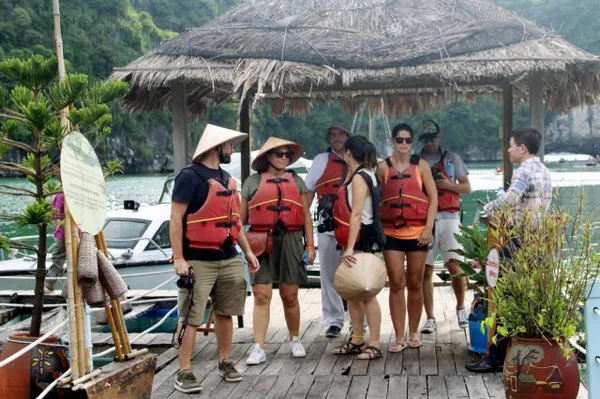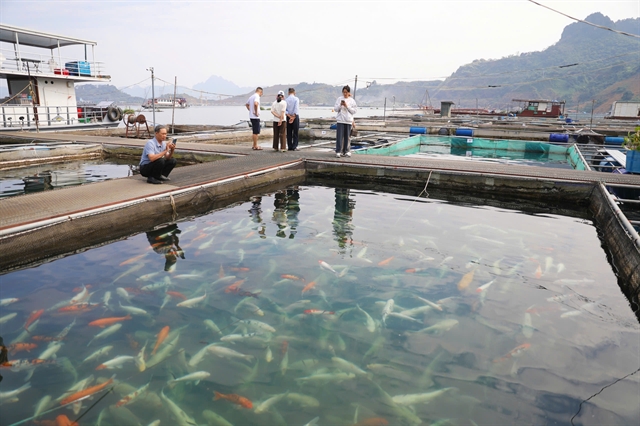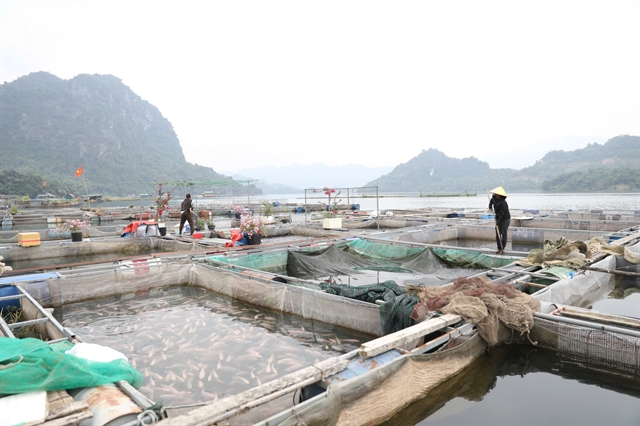 Society
Society

 |
| A fish farm floating on Hòa Bình hydropower reservoir of Hải Đăng Aquaculture Co., Ltd., in Hòa Bình City. — VNS Photos Đoàn Tùng |
Minh Hằng
HÒA BÌNH — Hòa Bình Province, in the northern region, is charting a new course for sustainable economic development by blending aquaculture with tourism.
This innovative approach is being realised in the picturesque Hòa Bình hydropower reservoir, where cage fish farming meets community-based tourism to create a dynamic and sustainable economic model.
The Hòa Bình reservoir, located just 70km from Hà Nội, was formed by the Hòa Bình dam in Đà River, the largest hydropower dam in Việt Nam and one of Southeast Asia’s largest reservoirs.
With more than 543 irrigation reservoirs of various scales across the province, the area is uniquely positioned for aquaculture, making the most of the vast 8,800-hectare Hòa Bình reservoir that spans districts like Cao Phong, Đà Bắc, Tân Lạc, Mai Châu, and Hòa Bình City.
In recent years, aquaculture has become a crucial livelihood for thousands of local households, offering a significant boost to incomes and generating economic benefits that ripple across the region.
Thriving industry
According to the provincial Department of Agriculture and Rural Development (DARD), floating cage fish farming on Hòa Bình reservoir has expanded rapidly.
The number of fish cages has nearly doubled from more than 2,300 in 2015 to almost 5,000 by 2023, marking an impressive annual growth rate of 14.4 per cent. As a result, fish production has surged from 1,400 tonnes in 2015 to over 5,380 tonnes by 2022.
Among the species farmed are Chiên, catfish, Diêu hồng (Oreochromis sp), black carp, Bỗng, sturgeon, grass carp and tilapia.
What began as a modest industry using traditional wooden, bamboo, and rattan cages has evolved into a robust sector employing larger, more modern metal-framed nets and environmentally friendly materials that are capable of producing substantial quantities of fish annually.
One of the early adopters of integrating aquaculture with tourism is Nguyễn Thị Bảy, director at Hải Đăng Aquaculture Co., Ltd., a key player in Hòa Bình’s thriving aquaculture scene.
Bảy attributes the region’s success to its pristine water quality, which is ideal for sustainable floating cage fish farming.
"The water here is excellent for aquaculture – it's very clean, and there are no pollution sources," she said. "We farm according to VietGAP standards, ensuring that the fish are clean, safe and of the highest quality."
Since its inception in 2015, Hải Đăng in Hòa Bình City has grown from modest beginnings to a major player in the industry. The company now spans five hectares and operates 200 cages, producing between 450 and 500 tonnes of fish annually.
 |
| Visitors enjoy an immersive experience at Hải Đăng Aquaculture Co., Ltd.'s fish farm. |
While Hải Đăng’s products are primarily sold locally, 80 per cent of the fish reach Hà Nội’s market and the company’s catfish floss product has earned a coveted OCOP 4-star certification. This success is a testament to the clean water in the Hòa Bình reservoir and modern farming methods.
The provincial authority has been a key enabler of the sector’s success, introducing initiatives to support the development of aquaculture, including financial aid for cage purchases, technical training and assistance with building collective brands.
These measures have also fostered job creation, with Hải Đăng Seafood Company alone employing over 40 local workers with a monthly salary of VNĐ9 million (over US$350).
"We’ve created jobs and supported small farms in adopting VietGAP standards to bring their products to markets," Bảy said.
Challenges in scaling up
Despite these achievements, the sector is not without its challenges.
Poor management in certain parts of the reservoir has led to declining fish stocks and rare species such as Anh Vũ and Dầm Xanh are at risk of extinction.
In response, over 246,000 fish have been released back into the reservoir since 2015 to help replenish stocks and authorities have launched campaigns to educate farmers on sustainable fishing practices.
“However, issues like illegal fishing practices, including the use of electricity and explosives, continue to threaten the ecosystem. Another pressing concern is the volatile market conditions, which have made it difficult for fish farmers to secure stable, long-term buyers,” said Nguyễn Huy Nhuận, Director of the provincial Department of Agriculture.
Bùi Thị Thoa, who is a Mường ethnic farmer from Ngòi village, Suối Hoa Commune, Tân Lạc District, explained: "Despite having over 30 cages, I struggle to sell my fish, and I’m facing mounting debts for feed. It’s a challenge to find reliable buyers.
"We’re currently deep in debt, owing hundreds of millions of đồng for fish feed. Each week, feeding our fish costs over VNĐ20 million (over $780). Some cages have been stocked for an entire year, yet we haven’t been able to sell the fish.
"Finding buyers is incredibly tough, it’s mostly retail sales. Like many other fish farmers here, we don’t have a stable market. I sell whatever I can, little by little, to chip away at the debt to our feed suppliers. I’d love for the local authorities to help us secure stable markets for our products, but the prices must be fair for us to consider signing any contracts," Thoa said.
According to a report from DARD, although the aquaculture sector is experiencing impressive growth, it remains fragmented, with many small, poorly organised operations.
Only 10 per cent of fish cages are officially registered and fewer than 20 per cent have attained VietGAP certification.
Moreover, modern infrastructure and technology are lacking, making it difficult for local farms to add value to their products and compete effectively in the market.
Bridging tourism and aquaculture
The integration of tourism with aquaculture, however, is gaining traction.
Local authorities have identified tourism as a key opportunity for diversifying the region’s economy while promoting sustainable practices.
New initiatives are aiming to combine fish farming with tourism experiences, such as boat trips on the Hòa Bình reservoir that allow visitors to explore fish farms and sample local delicacies. This novel concept provides tourists with a fresh perspective on aquaculture and opens up new economic avenues for local communities.
 |
| A floating fish farm of Bùi Thị Thoa, a farmer from Ngòi village, Suối Hoa Commune, Tân Lạc District. |
As of 2024, Hòa Bình’s tourism sector has seen significant growth, with 107 accommodation establishments providing jobs for 1,200 people, 700 of whom are directly involved in tourism.
International visitor numbers have risen by 10.3 per cent annually from 2015 to 2023, with significant interest from Europe, the US and East Asia. Domestic tourism has also grown, increasing by 18.3 per cent annually over the same period.
Hải Đăng Aquaculture Company, a pioneer in this integration, is now offering tourist services such as day tours around the reservoir, visits to local cultural sites, and boat trips to fish farms.
While most of the tourists are still local, the company is optimistic about the future potential of combining tourism with aquaculture.
"We believe this model can unlock significant opportunities for us," Bảy said.
In regions where selling aquaculture products remains a struggle, tourism has yet to gain traction, leaving untapped potential for economic growth.
Thoa's village of Ngòi, although home to a thriving aquaculture industry with nearly 90 per cent of households involved in fish farming, has not seen significant development in the tourism sector.
The party secretary of Ngòi village, Đinh Công Hoán explained that “In the past, ethnic communities had little understanding of tourism and its opportunities. While awareness has improved considerably in recent years, the development of tourism remains a low priority.
“Only five or six households in the entire village are involved in the sector, which is far from enough to meet the rising demand for accommodation. This lack of infrastructure continues to hold back the area's ability to attract and retain visitors.”
According to development plan, by 2030, Hòa Bình Province aims to establish eight concentrated aquaculture zones around the Hòa Bình reservoir, integrating cage fish farming with tourism while ensuring environmental protection and hydropower operations.
The province plans to expand to 10,000 fish cages, producing 16,000 tonnes annually with a value of VNĐ500 billion ($19.69 million).
All fish farming facilities will be equipped with technical knowledge and tourism management skills, with 80 per cent adopting VietGAP or equivalent standards, combining aquaculture with tourism activities. These efforts are expected to attract 1.6 million visitors annually and create jobs for 4,000 workers, including 1,600 directly employed in the sector.
"Our vision is to establish a brand rooted in environmental protection and social progress," Nhuận said.
"We aim to develop a model that sets the standard for aquaculture, achieving a balance between economic advancement and ecological preservation." — VNS




